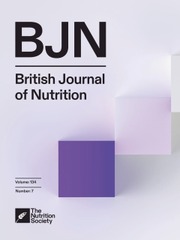No CrossRef data available.
Article contents
Impact of Breakfast Consumption Timing versus Breakfast Omission on Post-Lunch Glycaemia and Insulinaemia in Adolescent Girls: A Randomised Crossover Trial
Published online by Cambridge University Press: 14 February 2025
Abstract
Adolescent girls often skip breakfast due to time constraints and reduced morning appetite. This study examined the acute impact of breakfast consumption timing versus breakfast omission (BO) on glycaemic and insulinaemic responses to lunch in infrequent breakfast-consuming girls. Fifteen girls (13.1±0.8 years) completed three conditions in a randomised crossover design: early-morning breakfast consumption (EM-BC; 8:30), mid-morning breakfast consumption (MM-BC; 10:30), and BO. A standardised lunch was provided at 12:30, followed by a 2-h post-lunch observation period. Blood and expired gas samples were collected periodically. Linear mixed models with Cohen’s d effect sizes compared outcomes between conditions. Pre-lunch glucose and insulin incremental area under the curve (iAUC) were higher in the breakfast conditions versus BO (P≤0.009), with no differences between breakfast conditions. MM-BC reduced post-lunch glucose iAUC by 36% and 25% compared with BO and EM-BC, respectively (P<0.001, d=0.92–1.44). A moderate, non-significant 15% reduction in post-lunch glucose iAUC was seen with EM-BC versus BO (P=0.077, d=0.52). These reductions occurred without changes in post-lunch insulinemia (P≥0.323) and were accompanied by increased post-lunch carbohydrate oxidation compared with BO (P≤0.018, d=0.58–0.75); with no differences between EM-BC and MM-BC. MM-BC lowered glycaemic response over the experimental period compared with BO (P=0.033, d=0.98) and EM-BC (P=0.123, d=0.93), with no difference between EM-BC and BO. Compared with BO, both breakfast conditions lowered post-lunch glycaemic responses with mid-morning breakfast eliciting a greater second-meal effect than early-morning breakfast. These findings indicate the breakfast-to-lunch meal interval may be a crucial factor affecting postprandial glycaemia in infrequent breakfast-consuming girls.
- Type
- Research Article
- Information
- Copyright
- The Author(s), 2025. Published by Cambridge University Press on behalf of The Nutrition Society


